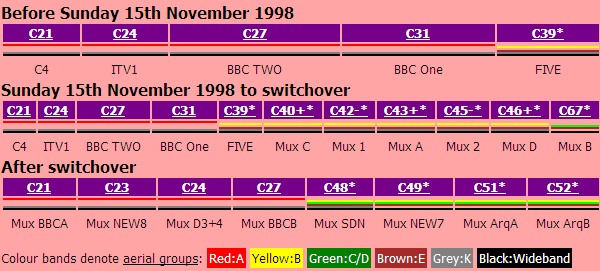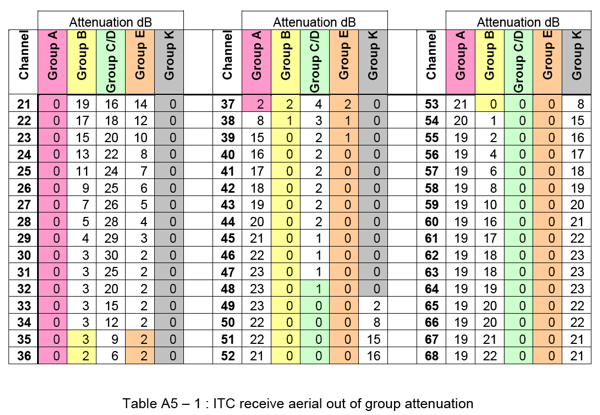Aerial groups - new feature
 Brian Butterworth published on UK Free TV
Brian Butterworth published on UK Free TV In the olden days of black and white, 405-line television, when the frequencies used were "very high" (VHF), the UK two-channel television service was provided using a just 100 transmitters and reception needed a standard aerial.
Later the system was upgraded to "ultra high frequencies" (UHF) for colour and now uses over 1,120 transmitters with more channels on more frequencies.
To enable the best quality reception possible, UHF television aerials are produced in a number of "groups". Each group is designed to operate on a range of channels, blocking all others. This is to prevent interference from "other" transmitters and to decrease losses on those required.
Each group is designated a colour, which is used to mark the aerial. Whilst wideband (black) aerials are designed to receive on all frequencies, their performance can be below a grouped aerial.
The transmitter pages now show a table like this:

The three sections show the three phases. The first is that before digital TV was introduced. This example shows that a group A (red) aerial would have received the original four channels but a group K was required to also receive FIVE. The channel number for FIVE on analogue is shown with an asterisk because it is "out of designated group", group A.
The second section shows the "digital with analogue" phase, where the transmitter has the analogue services from above with the new low power digital services. It can be clearly seen that on this transmitter a group A aerial will not receive any digital services at all, and that even a group K aerial will not receive the multiplex B service on C67. The only choice for digital reception here is a wideband (black) aerial because it is the only coloured band that crosses from left to right.
(You can also see that some of the digital services have plus and minus symbols. This indicates these transmissions use a 166.67kHz offset.)
The final section shows the designated frequencies that will be used for digital television after switchover. Whilst the public service multiplexes BBCA, BBCB, D3+4 are back "in group" (group A), to receive all the multiplexes, including the two potential new ones, the only choice here is wideband.
The performance of grouped aerials for each transmission channel was defined by the old Independent Television Commission (ITC) and is:

The larger the value, the lower the signal level possible.
Bill: No, it isn't likely at all!
See:
Londonderry transmitter | ukfree.tv - 10 years of independent, free digital TV advice
| link to this comment |
7:19 AM
Accrington
Group aerials are no good in todays freeview environment-especially if they have been up on a roof for years and/or are old corroded or knackered, ageing rusty corroded bent twisted or knackered aerials will not pick up all the Freeview channels as a good quality log periodic aerial installation or good quality wideband high gain aerial installation, condition of aerials and cabling can make all the difference between getting something, getting breaking up pixellating tv services or getting nothing at all.
| link to this comment |
Anthony's: mapA's Freeview map terrainA's terrain plot wavesA's frequency data A's Freeview Detailed Coverage
5:25 AM
Grouped aerials ARE still around look for it in Ebay etc...... I just brought an Group A for London and Group B for Hannington and Group C/D for oxford..... BRAND new aerials YES Triax aerials and Blake , Antifereance, all still doing grouped aerials.... I think your talking a load of horse bag of poo...... Please Research the internet before making inane comments!!!
| link to this comment |
8:15 PM
Trowbridge
Rob:
In the near future, Ofcom are likely to authorise more changes to the frequencies used for DTV. Those will make most 'grouped' aerials redundant if the are unable to receive a satisfactory signal in Band 4. A Group A could work for most multiplexes but may not be good for some of the HD ones coming soon. Group B and C/D will be of little use after the expected changes. A good Log-Periodic, such as a log36 type, is more likely to be capable of giving reliable reception now and after the changes. An alternative is a Group K aerial which is likely to cover the needed frequencies.
Buying a grouped aerial is not a good idea in view of the expected alterations to enable more of the UHF spectrum to be sold to mobile operators.
Much of what Anthony stated is quite valid. Just because grouped aerials are available does not mean they will serve for as many years as people expect.
| link to this comment |
MikeP's: mapM's Freeview map terrainM's terrain plot wavesM's frequency data M's Freeview Detailed Coverage
8:13 AM
This is by way of a comment:
My TV aerial is plasterboarded in to the apex of the loft. It was rescued from Mum's house around 20 years ago after being thrown out. I had to shorten it to fit the space. It has run three sets (one on each floor) perfectly, with never a hiccup, ever since; didn't grumble once during the changeover to digital and still going strong.
Don't you just love technology.
P.S Thank you for the really useful site.
| link to this comment |
12:55 PM
Hi, does anyone have any idea who could build a communal tv tower at a new build where sky isn't available due to very large protected trees and there isn't any cable? Thanks
| link to this comment |
9:21 PM
Any one else having signal problems in Ashbourne, Derbyshire? My Mum lives in a retirement block which is about 12 years old and she constantly has problems with her Humax box not working due to poor signal.
| link to this comment |
10:28 AM
Karen: Hi, Karen. If the apartment block is rented from a local council or housing association it will have a sub-contractor responsible for ensuring that all residents receive a good signal: it is the responsibility of the council or HA to ensure that this is the case, so if your mother is experiencing reception problems she should report these to the council or HA in the first instance and they will send out their aerial system sub-contractor to investigate. Our block lost its signal altogether a fortnight ago, but the sub-contractor came out the same afternoon and I was back in watching Neighbours at 5:30 p.m. If, on the other hand, your mother owns her apartment in the retirement block, then she probably pays a service charge for the communal aerial system, so get her to check that her service charge covers it and then, assuming it does, get on to the firm that holds the contract to maintain the aerial system and call them out. Hope all this info is of assistance, Richard, Norwich.
| link to this comment |
9:32 AM
Has something been done at the Rowridge transmitter to weaken the BBC1 signal? I have been receiving satisfactorily for many years but fo the last 3 weeks or so am having severe problems.
| link to this comment |